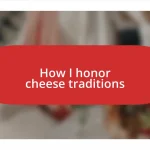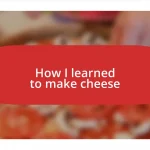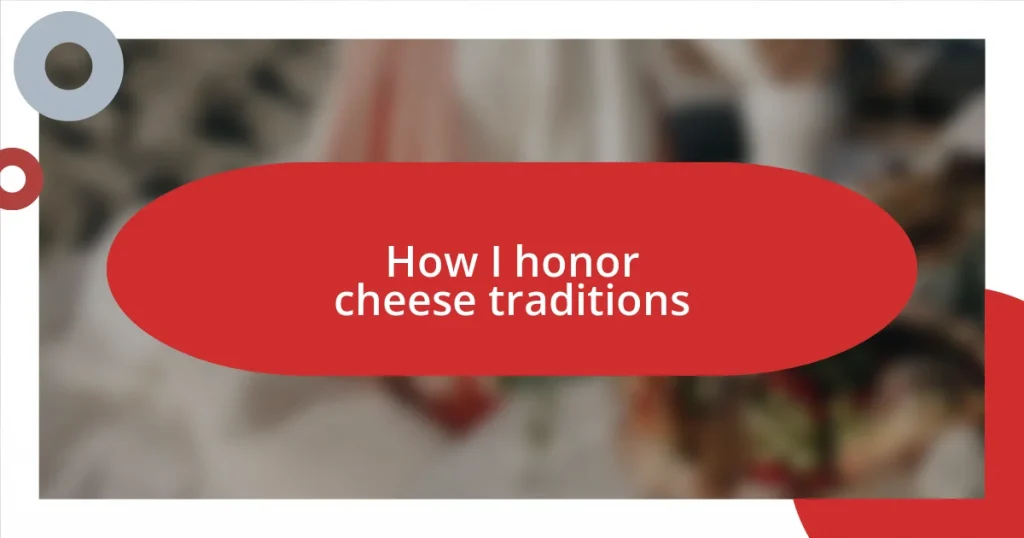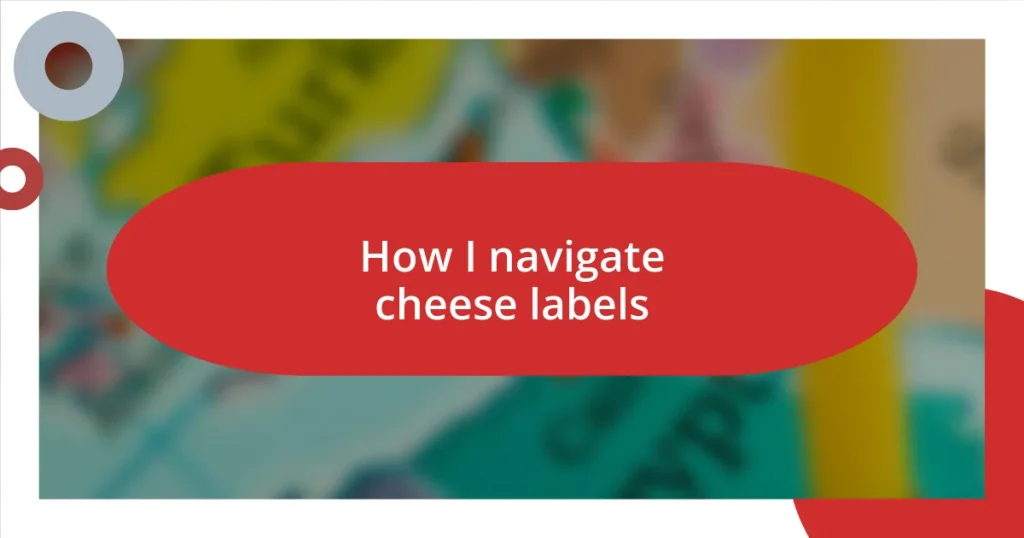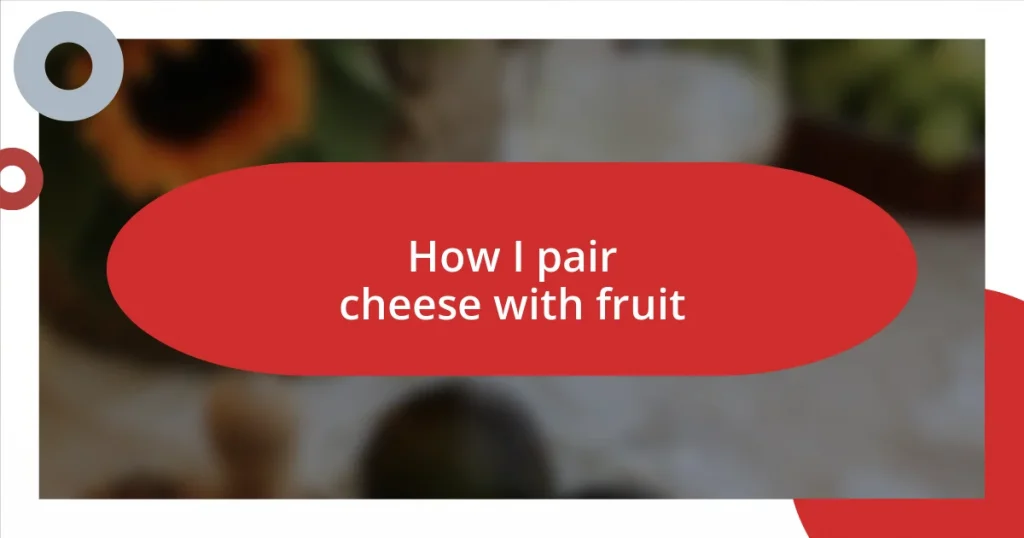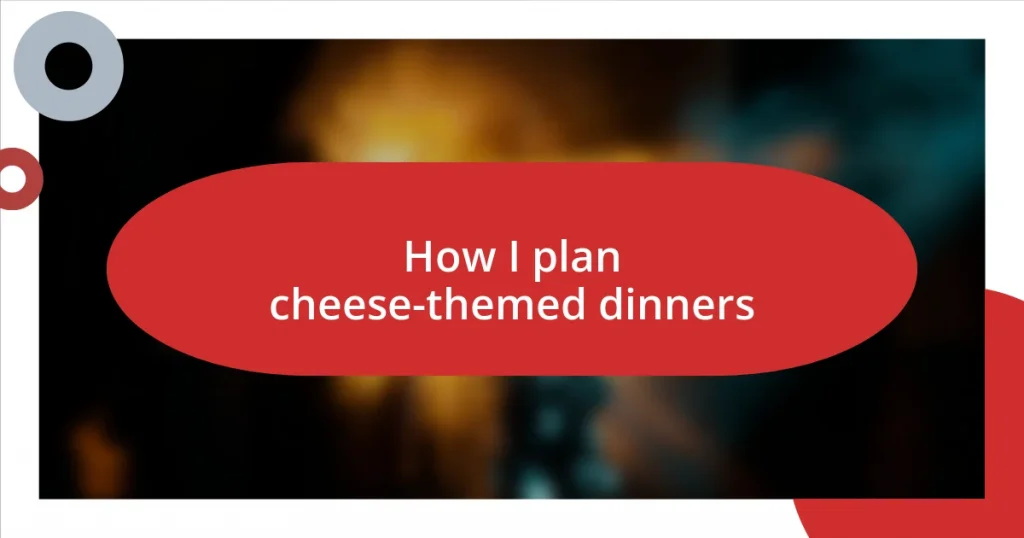Key takeaways:
- Cheese is a cultural cornerstone, with each type reflecting regional traditions, crafting methods, and local identity.
- Artisanal cheese makers are dedicated artisans whose work embodies history, community connections, and culinary heritage.
- Cheese pairings and tastings enhance appreciation and foster social bonds, turning meals into memorable experiences filled with storytelling and creativity.
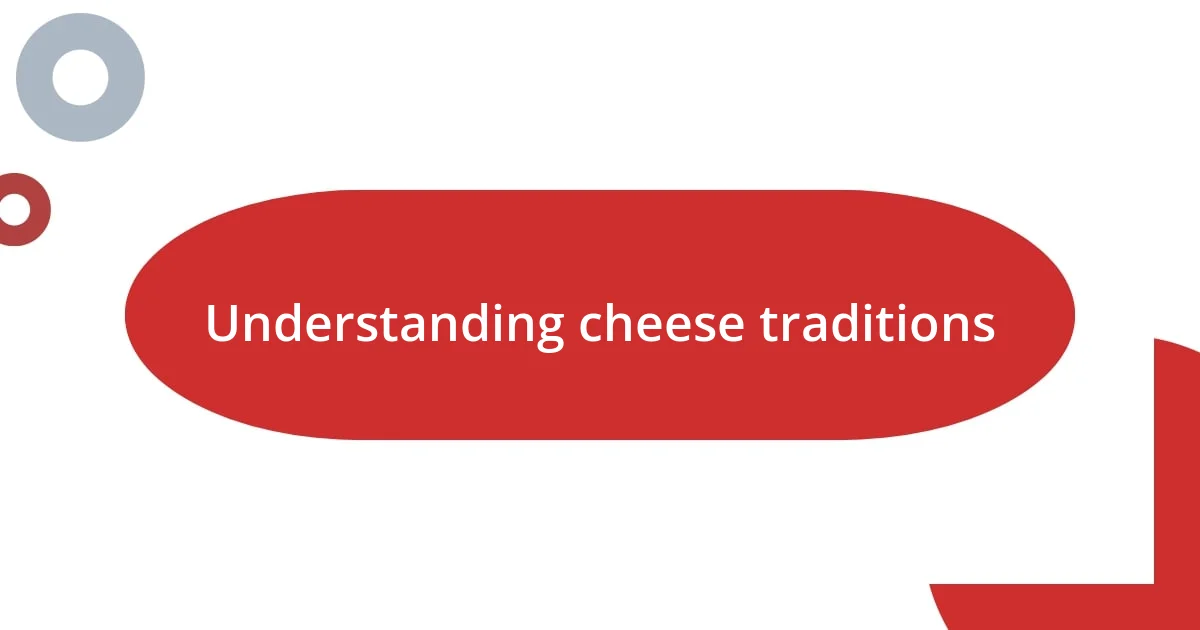
Understanding cheese traditions
Cheese traditions are fascinating windows into cultures around the world. I vividly recall my first visit to a small cheese maker in Italy, where the air was thick with the scent of aging pecorino. The artisan, with his stories of generational recipes and local herding practices, truly brought to life how cheese isn’t just a product; it’s a cherished part of cultural identity.
I often wonder, how many people realize that every cheese has a story tied to its region? Take Roquefort, for instance, with its unique blue veins formed by local molds. Each bite carries centuries of tradition, shaped by the landscape and the craftsmanship of dedicated cheese-makers. Experiencing this firsthand, I felt a profound connection to the land and its people that I hadn’t anticipated.
Understanding cheese traditions means appreciating the deep-rooted practices that govern how each cheese is made and enjoyed. I remember sharing a wheel of farmhouse cheddar with friends, the flavors richer because of our shared experience. Those moments reminded me that cheese traditions are not just about taste; they’re about memory, community, and the connections forged over a shared love for this beloved dairy delight.
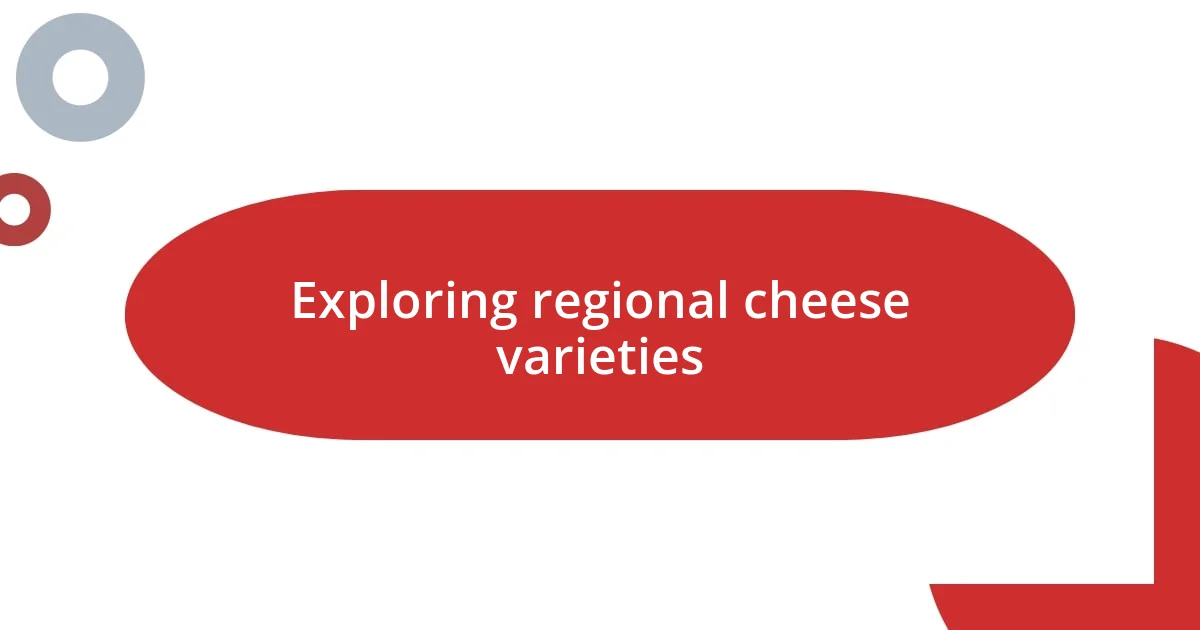
Exploring regional cheese varieties
As I dive into the world of regional cheese varieties, I find myself entranced by the sheer diversity that exists. Each region has its signature cheese, shaped by climate, terrain, and local customs. I recall a memorable road trip through the French countryside, where I stumbled upon a quaint village known for its goat cheese. The locals proudly showcased their artisanal creations—tangy, creamy, and bursting with flavors that reflected the herbs from nearby pastures. It was as if the cheese encapsulated the very essence of the land.
Here are some notable regional cheese varieties that exemplify this diversity:
- Parmigiano-Reggiano (Italy): Known as the ‘King of Cheeses,’ it has a nutty flavor and granular texture, thanks to its unique production methods in a specific area of Italy.
- Comté (France): A cow’s milk cheese from the Jura region, celebrated for its complex flavors, resulting from the diverse flora the cows graze on.
- Queso Blanco (Mexico): A fresh cheese that is mild and versatile, often used in salads or fried dishes, connecting to traditional Mexican cuisine.
- Feta (Greece): This brined cheese, typically made from sheep’s milk, carries a tangy flavor that perfectly complements Greek salads and other Mediterranean dishes.
- Gorgonzola (Italy): One of the world’s oldest blue cheeses, with a creamy texture and a unique blend of sweet and sharp notes, deeply tied to the Italian cheese-making heritage.
Exploring these regional varieties not only tantalizes the taste buds but also unveils stories of traditions and local pride that resonate emotionally. For me, these experiences have become cherished memories where flavor meets the rich tapestries of culture.
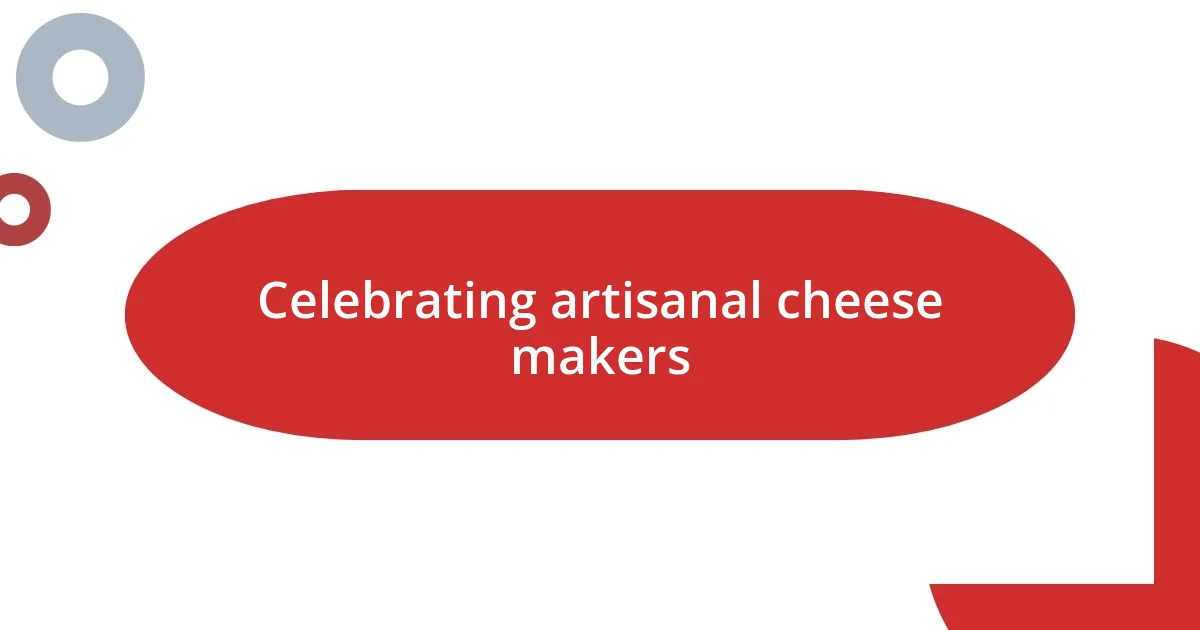
Celebrating artisanal cheese makers
Celebrating artisanal cheese makers is truly a delightful experience for me. I remember attending a cheese festival where I met a passionate cheese maker from the Swiss Alps. Each of her cheeses told a tale of the specific mountain pastures where her cows grazed. I could taste the fresh, rich grass in her Gruyère—what an incredible link between flavor and geography!
What strikes me most about these artisans is their unwavering dedication. They often spend years perfecting recipes and techniques, sometimes passed down through generations. I met a young cheese maker in Vermont who took immense pride in crafting his own version of cheddar. Watching him work was enlightening; every cut and stir was imbued with a respect for the craft and a love for the flavor that so many of us enjoy.
The artistry of cheese making transcends mere production; it’s about nurturing relationships with the land and the community. I’ll never forget my visit to a family-run goat farm in California. The cheese maker invited me to help with the milking process—an experience that deepened my appreciation for every crumb of her soft goat cheese. Each cheese maker I meet reinforces my belief that they’re not just creating cheese; they are carrying forward culinary traditions that foster a sense of belonging and purpose.
| Cheese Maker | Location |
|---|---|
| Giulia | Switzerland |
| Ryan | Vermont |
| Anna | California |
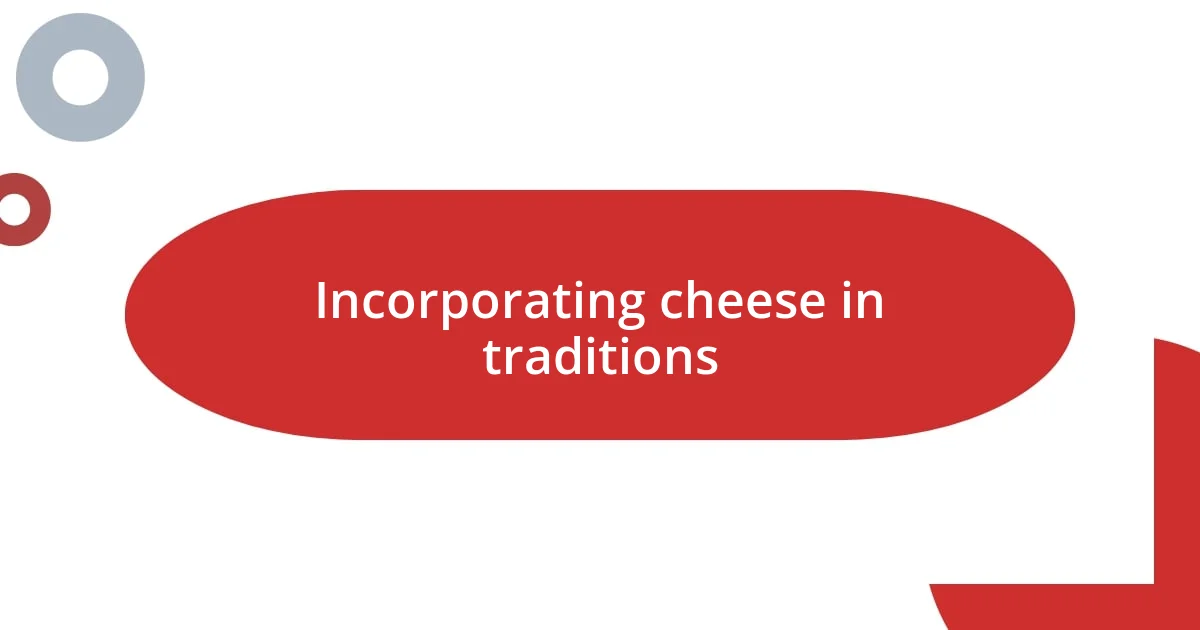
Incorporating cheese in traditions
In many cultures, cheese isn’t just a food; it’s a central component of classic rituals and celebrations. I recall attending a wedding in Italy where the cheese course was treated with reverence. It wasn’t just about serving cheese; it was an elaborate affair, with tables filled with different varieties, each one telling a story and symbolizing different aspects of life and love. Such moments remind me of how food, especially cheese, can cultivate shared experiences and reinforce traditions.
During the holiday season, I often prepare a traditional cheese platter that reflects my family’s heritage. It’s become a cherished ritual on our dinner table—each cheese selected holds a memory or story. For instance, the aged Gouda brings back memories of my grandmother’s kitchen, where we would gather and share laughter. Isn’t it fascinating how a simple cheese can transport us to a moment in time? Incorporating personal anecdotes into food traditions deepens the connection to our roots.
Exploring international cheese-making traditions, I was struck by the French custom of pairing cheese with specific wines. I learned to appreciate how the flavors intertwine, creating a sensory experience that’s rich with history. This practice has inspired me to host my own wine and cheese nights, encouraging friends to share their stories while we savor different combinations. It’s these personal touches that elevate cheese from an ingredient to a beloved tradition, weaving it into the fabric of our lives and celebrations.

Pairing cheese with complementary foods
Pairing cheese with complementary foods is one of those delightful culinary adventures that can elevate every meal. I remember trying a tart, robust blue cheese alongside a drizzle of honey—talk about a flavor explosion! The creaminess of the cheese paired with the sweetness created a balance that lingered on my palate long after the last bite. Have you ever tried something you thought wouldn’t work, only to be pleasantly surprised?
Then there’s my ongoing love affair with cheddar and apples. The sharpness of a well-aged cheddar, combined with the crisp juiciness of a honeycrisp apple, is a match made in heaven. I discovered this pairing during a picnic with friends, and ever since, it’s become a staple. The savory and sweet elements complement each other perfectly, reminding me that sometimes, the best flavor combinations come from nature itself.
When it comes to hosting gatherings, I find that serving a cheese board with assorted nuts, fruits, and artisanal bread creates a beautiful, interactive experience. Watching my guests mix and match, discovering their perfect bites, sparks joy in me. It’s like bringing them into my world and inviting them to create their own unique combinations. Have you ever noticed how food has a way of sparking conversations? Pairing cheese with other foods opens doors to creativity and connection, making every gathering memorable.

Hosting cheese tastings for appreciation
Hosting cheese tastings is an exquisite way to honor cheese traditions, and I’ve found that it brings friends and family together in delightful ways. One memorable evening, I invited close friends over for a cheese tasting themed around the regions of France. Each cheese we tasted came with its own story, and as we sampled the nutty Comté and smooth Brie, we shared laughter and memories, which deepened our connection. Have you ever felt that profound sense of togetherness when enjoying good food? It’s those moments that make life rich.
I always emphasize the importance of thoughtfully curating the tasting experience. I once hosted a gathering where I not only included a variety of cheeses but also paired each with unique accoutrements—fig jam, roasted nuts, and fresh fruits. As everyone indulged, I encouraged them to share why they chose their pairings, leading to conversations that flowed as smoothly as the wine. This interaction turns a simple cheese sampling into a culinary adventure, making it feel less like a formal event and more like a cozy conversation among friends.
What I love most about these tastings is how they spark curiosity. During one gathering, a friend asked about the differences between sheep’s milk and cow’s milk cheeses, which led to an impromptu cheese-making lesson straight from my experiences in local dairies. Sharing knowledge and personal insights creates an educational experience around cheesemaking traditions that is both fun and enlightening. Have you explored the stories behind the cheese you enjoy? It feels incredibly rewarding to delve into the craft behind these beloved traditions while building lasting memories around the table.





